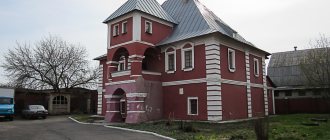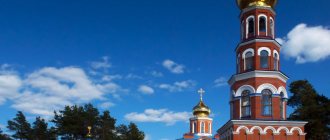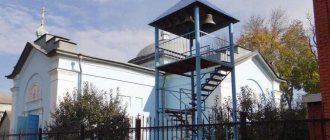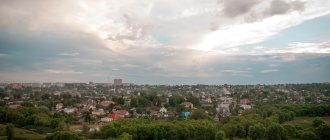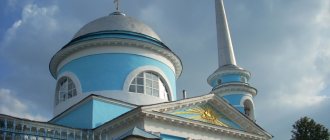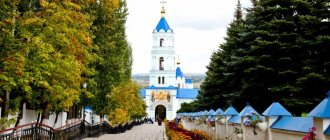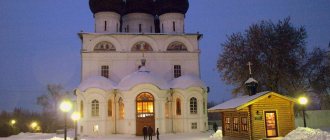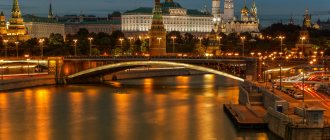Pervomaisky Park
Located in the Central District, at the address: st. Uritsky, 5.
Located at a distance:
- 25.2 m – from the building of the Administration of the Kursk Region;
- 115 m – from the Znamensky Cathedral;
- 142 m – from the Museum of Local Lore.
It borders on Red Square, Uritsky and Sonin streets.
It occupies an area of 14 hectares. Landscaped green space. Located on a hill. From st. Uritsky to st. Sonina passes through the central alley, dividing the territory in half. On the outskirts of the park there are attractions for children and adults.
In the eastern part there is a Ferris wheel; it offers views of the Tuskar River and Streletskaya Sloboda. Along the alleys there are benches, gazebos and lanterns. At the entrance to the park from Red Square. A monument to Alexander Nevsky was erected on a high cylindrical pedestal with the inscription: “God is not in power, but in truth.” From it there is a path with flower beds.
Zones highlighted:
- recreation (with gazebos, benches);
- entertainment (with rides, playground, trampolines, slides);
- sanitary zone.
54.9 m from the monument to A. Nevsky, a bust of Hero of the Soviet Union A. E. Borovs was installed. There is a cafe.
Bryansk region
Distance from Kursk - 170 kilometers
In the village of Lopandino, on the border of the Oryol, Kursk and Bryansk regions, you can find one of the largest estates in the Black Earth Region. Its owner, a large landowner Maria Voeikova, owned a sugar factory in the Komarichsky district. Voeykova lived 6 kilometers from the plant, in the neighboring village of Radogoshch. It was inconvenient to get there, so the decision was made to build an estate in Lopandino. All this happened at the beginning of the 20th century. The time was approaching revolution. Voeykova, having a presentiment, decided to make the estate strong, high and set up guards in the form of Cossacks. The peasants received little at the factory, and life in the village did not suit them, so they constantly came to her with requests. Maria Vladimirovna fulfilled some of the requests: she raised wages, built new houses for workers, built a school and built a hospital. But the wave of revolution could not be abandoned: the peasants demanded more. By 1917, Voeykova and her family fled to Paris, and her castle passed into Soviet hands. At first there was a school there, then a college, a school, and now the estate is being destroyed and overgrown with grass. And the sugar factory is still operating.
. . .
Ermoshkino Lake
Located in the Seimsky district, at the address: st. Gagarina, 23.
Located at a distance:
- 65 m – from residential buildings;
- 282 m – from the Polytechnic College;
- 351 m - from the Patriot sports club.
At 743 m there is a busy highway - Kulakova Ave.
Recreational space in a residential neighborhood. In the center there is an artificial reservoir (pit) with an uneven bottom, with sharp depressions. The size of the water surface is almost 60,000 m2; the depth reaches 8 - 10 m. Trees grow around the lake. Pedestrian paths in the coastal area are paved. Lanterns and benches are installed along them.
There is a recreation area with a sandy beach around the lake. There is a rescue station. A volleyball court and a small sports ground with horizontal bars have been created on the banks. There is a cafe 27 m from the lake.
Park named after Heroes of the Civil War
Located in the Central District, at the address: st. Dimitrova, 75 a.
Located at a distance:
- 27.6 m - from the Civil Registry Office of the Central District Administration;
- 48, 8 m – from the art gallery named after. A. A. Deineki;
- 326 m - from the Music College named after. Sviridova.
Bounded by Radishchev, Gogol, Dimitrov streets and lane. Gogol.
It occupies an area of 4 hectares, of which about 75% is forest. Well-maintained recreational space. From the entrance from the street. Dimitrova there is a long alley. In the center of the park there is a monument to 29 heroes - revolutionaries shot by Denikin’s soldiers, and the Eternal Flame. The monument is recognized as an object of cultural heritage of Russia.
At 44.7 m to the right of it is a monument to the victims of political repression. Illuminated paths are tiled. Benches have been installed. Flowerbeds and lawns are broken.
An entertainment area with a children's playground and trampolines has been created. In summer, a brass band plays and dance evenings are held. A basketball court is equipped; In winter, people go skiing in the park. A designated sanitary zone.
Pioneer Park
Located in the Central District, at the address: st. Perekalsky, 1a.
Located at a distance:
- 27 m – from the Regional Philharmonic;
- 63 m – Kursk Medical University;
- 109 m - from Kursk State University.
Bounded by st. Perekalsky, st. Blinov and per. Blinova.
Landscaped green space. Children's park. In the center there is a large flower bed. The central paths are tiled, the side paths are paved. There are lanterns and benches along them. Flowerbeds are broken. At the end of the central alley, from the street. Blinov, a monument to V.I. Lenin .
A Glade of Fairy Tales with fairy-tale characters made of wood was created. The park is decorated with numerous sculptures depicting children and animals. One of the oldest parks in Kursk. It is part of the Palace of Pioneers and Schoolchildren.
There is a designated seating area with benches in shady alleys. There is a large sports area with a basketball court and a football field. In winter the skating rink is filled. A safe playground is open.
The most interesting historical monuments
Historical monuments are a reflection of the past. Who, if not they, can preserve for so long the memory of events that are so significant for humanity.
Water mill in Krasnikovo
- Coordinates: 51.255736, 36.417597.
A unique historical and architectural monument is located near the town of Oboyan. This is an old mill, built in 1861. Every year, tourists not only from Russia, but also from neighboring countries come to the Kursk region to see this wonderful building, which is considered one of the best examples of wooden architecture. In our country there are only a few such mills left, built without a single nail, and in the Central Black Earth Region it is the only one.
Its first owner was a Polish landowner who fled the country during the civil war. After the revolution, the mill was nationalized and it became state property. Even when the era of electric flour mills arrived, this ancient mill continued to work, grinding wheat grains between two millstones. Her work stopped in the early 2000s.
Today, the area around it has been restored, asphalt access roads have been installed and recreation areas have been created. The mill itself came under the jurisdiction of the Kursk Museum of Local Lore, and the pond on which it stands became a favorite vacation spot for residents of the region.
Shamil Tower
- Coordinates: 51.672493, 35.275029.
In the former Lgov estate of the Baryatinsky princes, a building with an interesting legend has still been preserved. This three-tier tower, surrounded by oaks and larches, was built in 1870 by the prince's younger brother. The pseudo-Gothic style, the spiral staircase connecting the tiers, went perfectly with the openwork fence, the new beautiful house and was fully consistent with the architectural trends of that time.
It was named Shamil Tower in honor of the famous Chechen imam - a symbol of the Russian-Caucasian War of the 19th century. If you believe the legend, Shamil prayed and performed namaz in it during his captivity by the prince’s third brother. Another version says that the imam was imprisoned in this tower, but it is not confirmed by historians. Despite this, the structure, somewhat reminiscent of Muslim minarets, is still called the Shamil Tower in his honor.
Memorial complex in the village of Svoboda
In 1943, the main command post of the central front was located in this place. Today, a historical and memorial complex has been opened, by visiting which you can learn a lot of interesting things about the activities of the command post and preparations for the Battle of Kursk.
Among the exhibits are personal belongings of commanders, the chief of staff and the chief of engineering troops, and one of the exhibitions is entirely dedicated to Marshal Rokossovsky. It bears the loud name “From Soldier to Marshal”.
Here you can see his personal belongings, donated to the museum by the wife and daughter of Konstantin Konstantinovich, as well as the dugout from which he commanded the front. In addition, on the territory of the memorial complex there are samples of military equipment, a bust of Rokossovsky and a sculpture of the liberating warrior.
Memorial complex Big Oak
- Coordinates: 52.267090, 35.339292.
Once upon a time there was a small village on this site. He bore his name, received in honor of an ancient, 600-year-old giant oak tree, with pride. After all, this tree had no equal in the entire area. On October 17, 1942, both the oak tree and the village were destroyed by the Nazi-German invaders. Residents, among whom were 26 children, were shot for helping the partisans.
On the 30th anniversary of the Great Victory, the grand opening of the memorial complex took place. At the site of the execution, a sculpture of the Big Oak was erected, an eternal flame was lit, and where the houses stood there were now charred log houses with bell towers in the form of a chimney in the center. A little later, a museum of partisan glory was opened on the site.
Park of Culture and Recreation named after the 50th anniversary of the Komsomol (Boeva Dacha)
Address: Russia, Kursk, Boeva Dacha park. Located in the Central District.
Located at a distance:
- 418 m – from Zheleznodorozhnikov Park;
- 656 m – from Pioneer Park;
- 1.61 km – from the Trinity Monastery.
Bounded by Perekalsky, VChK, Tuskarnaya streets.
A large park with a natural landscape with hills and a plain, a river and a lake flowing into it. The Tuskar River divides the park into 2 halves, connected by bridges. A significant part of the area is occupied by forest plantations. A place for active and beach recreation, sports.
The long, about 1 km, descent from the city center to the park is equipped with a wide staircase. Pedestrian and bicycle paths are paved. Dirt paths have been laid. Benches and lanterns are installed along them. Flowers are planted.
Zones highlighted:
- sports - with a platform with logs and stumps for cycling trials - an extreme sport; running club; 2 stadiums; horizontal bars
- Recreation - with 3 beaches (with changing rooms, awnings, benches).
- Entertainment - with children's playgrounds; trampolines.
- Public catering - with summer cafes.
- Sanitary zone.
There is a boat and bicycle rental service. Free parking. In the park, at a distance of 150 m from each other, there are 2 holy springs: in honor of St. Seraphim of Sarov and the icon of the Most Holy Theotokos “Life-Giving Spring”.
Park KZTZ (Kursk Tractor Spare Parts Plant)
Located in the Seimsky district, KZTZ microdistrict.
Located at a distance:
- 20 m – from the library named after. N. Yu. Korneeva;
- 164 m – from the Kursk flying club;
- 288 m – from the chapel of the icon of the Mother of God “Burning Bush”.
Bounded by Olshansky, Zavodskaya, Sumskaya streets.
Well-maintained recreational space. From the entrance from the street. There is a wide alley along Sumskaya, in its center blue spruce trees grow, flower beds and lawns are laid out. On either side of it there are pedestrian and bicycle paths bordering forest plantations.
The paths are tiled. There are lanterns and benches along them. In front of the alley there is a round flowerbed. On the outskirts of the park there is Children's Art School No. 6.
There is a designated seating area with benches. There is a sports area with a football field and a children's sports complex "Olympus". A large children's playground has been created. The Military History Museum “Young Defenders of the Motherland” is located on the territory. The park is under development.
Where can tourists go in the Kursk region?
This year, 44% of Russians did not intend to take a vacation. If you are one of these people, then we suggest you consider the possibility of relaxing on a weekend and within the Kursk region. Moreover, we have something to see. There are more than 4,500 monuments of archeology, architecture, history and monumental art alone. And you don’t have to pay a resort fee.
In recent years, the number of hotel rooms in the Kursk region has doubled, which has allowed the region to take sixth place in the Central Federal District in terms of growth in tourist attractiveness. The average cost of living in Kursk hotels was 2,350 rubles per day.
There are two brands in the region that are recognizable throughout the country - the Kursk Bulge memorial complex and the Kursk Magnetic Anomaly. Also, the city of Kursk took 13th place among the cities of military glory of Russia, which are popular among tourists.
By the way, not so long ago the Kursk region was included in the federal mobile guide “TopTripTip - Traveling around Russia”. The guide is presented in Russian and English; it allows you to search for specific places, receive information about all objects located in the vicinity, plan trips and receive notifications about events that will take place in these places during your trip. Tourists can “like” objects they particularly like, due to which each attraction in the region receives its own popularity rating and thus becomes known throughout the country. By the way, the guide does not require the Internet, just download it to your phone. Everything that can attract tourists in the Kursk region is presented in 6 information sections: “Religious Tourism”, “Military Glory”, “Cultural and Educational Tourism”, “Sculpture of the 21st Century”, “Entertainment”, “Event Tourism”.
According to the Kursk Region Youth and Tourism Committee, rural routes are especially popular among Kursk residents. For example, last summer, most often, guests and residents of the region came to the Pesochnoye farm in the Medvensky district, where various Orthodox and folk holidays and exciting quests took place.
Craft tourism is also being revived. For example, this year a children’s ethnographic route “On the Roads of Timoni” appeared in the Sudzhansky district. Here you can get acquainted with traditional folk crafts: pottery, carpet weaving, etc.
Ten main tourist routes of our region
1) “Kursk is the city of military Glory.” Sightseeing tour of the city of Kursk with inspection of key attractions and visits to large memorial complexes.
2) “Kursk Bulge. Fiery Heights" (along the Northern face of the Kursk Bulge).
3) “Kursk Bulge. Tank battle" (along the southern front of the Kursk Bulge).
4) “Kursk Magnetic Anomaly” - a sightseeing tour of Zheleznogorsk with a visit to the observation deck of the Mikhailovsky Mining and Processing Plant quarry and the Zheleznogorsk Dendrological Park.
5) “Orthodox shrine of the Kursk land.”
6) “Maryino - the Pearl of the Kursk Territory.”
7) “Literary and musical route” - a route with a visit to the memorial house-museum of composer G.V. Sviridov, located in an old mansion, the restored estate of the poet A.A. Fet, house-museum of N. Plevitskaya.
 Ecological route “Streletskaya Steppe” - a thematic excursion with a visit to the Biosphere Reserve named after. V.V. Alyokhina.
Ecological route “Streletskaya Steppe” - a thematic excursion with a visit to the Biosphere Reserve named after. V.V. Alyokhina.
9) “The Kursk region is rich in talents” - an excursion to the city of Lgov with a visit to the museums of A.P. Gaidar, A.N. Aseev, as well as the former estate of the noble family of the Stremoukhovs.
10) “Kursk is the capital of the Nightingale region.” Sightseeing tour with inspection of the main attractions, visiting sites of Orthodox culture, revealing the significance of the centuries-old historical and spiritual heritage of the Kursk land.
Interesting tourist spots
Rylsk city
The central district of Rylsk can be considered an open-air museum, because its oldest part has remained unchanged; buildings from the 18th-19th centuries have been preserved there. It preserved the “House of Peter I”, the “House of Shemyaka”, the Church of the Ascension of the Lord, and the Intercession Cathedral. Rylsk is the birthplace of the navigator and explorer of Alaska Grigory Shelikhov, the discoverer of Russian America; his house also stands untouched by time.
Walking along the central streets you can find a stone chapel from the late 19th century. Next to it there is a large metal cross, the top of which is visible from any part of the city. It also has many cathedrals and churches built in the 19th century.
Palace and park ensemble "Maryino"
The former estate of the Baryatinsky princes, who belonged to the highest aristocracy of the Russian Empire, is located just near Rylsk. It was built in the second decade of the 19th century in an extremely short time.
The three-story palace has preserved stucco ceilings, marble fireplaces, pieces of antique furniture, and parquet flooring made from the most valuable types of wood. It has cozy courtyards with countless flower beds, a magnificent English park with an area of 207 hectares with centuries-old and unique trees (180 tree species in total), shady alleys, emerald lawns, sunny meadows, and bridges. Round and oval ponds with two islands connected by bridges, one of which has a 16-column rotunda, and the other a Lutheran church, retain the romantic aroma of the early 19th century.
On the territory of the palace and park ensemble there is a sanatorium for the administration of the President of the Russian Federation. But absolutely anyone can visit its territory with a tour or on their own.
Central Black Earth Reserve
The Central Black Earth State Natural Biosphere Reserve named after Professor V.V. Alekhin is located in the Kursk region. Since 1979, it has been part of the UNESCO world network of biosphere reserves, and in 1998 it received a diploma from the Council of Europe. The area of the reserve is 5287.4 hectares. Several species of relict plants, which scientists call “living fossils,” have been preserved here. On the territory of the reserve you can walk along the ecological trails “Streletskaya Steppe”, “Reserved Oak Forest”, see the silvery sea of feather grass, walk along the Dubroshina tract, visit the country of living fossils in the Barkalovka section and visit the Museum of Nature. There is also an ancient stone statue - a Polovtsian warrior. Such statues were erected in three cases. In the first, when someone from the Polovtsian aristocracy died. The mound was filled up, and such a figure was placed on its elevation. In the second case, they were placed at crossroads and indicated the path to the nearest settlement. In the third case, they served as deities, they were worshiped and sacrifices were made. Presumably, the Kursk Polovtsian warrior was created in the 6-8 centuries.
Mountains and caves
The relief in the Kursk region is almost mountainous and the highest point is located on the border of the Fatezhsky and Ponyrovsky districts within the so-called Fatezh-Lgovskaya ridge. Its height is neither more nor less than 274 meters.
There are also a couple of caves in our region that are the subject of real legends. For example, near the village of Byki in the Kurchatovsky district there is Kudeyarova Mountain. They called her that in honor of the robber Kudeyar, who lived during the time of Ivan the Terrible. Legends say that his hiding place was at the foot of this hill.
And in the village of Ushakovo in the Fatezhsky district there is a real geological monument - an outcropping of a phosphorite slab with imprints of marine animals of the Upper Cretaceous period.
Water Mill
In the village of Krasnikovo, Pristensky district, there is a work of architectural art. The mill was built in 1861 on the Broad Ruchey River. Before the revolution, the owner of the mill was the Pole gentleman Foma Ignatievich Tityanets, whose house was located next to the mill.
The wooden mill, built without a single nail, is an example of wooden architecture. Over the course of a century and a half, stained oak piles have only become stronger. The millstones in the mill are ancient, for centuries, made of granite. This is the only such “miracle” in the Black Earth Region; there are only a few of these left throughout Russia.
Battle sites
In 1943, the Battle of Kursk changed the course of World War II. In the Kursk region there are more than a thousand military-historical monuments, various memorials dedicated to the feat of the Soviet people have been created. There is especially a lot of “evidence” of those exploits on Ponyrovskaya land. On the occasion of the 70th anniversary of the Victory in the Battle of Kursk, a memorial to the “Heroes of the Northern Face of the Kursk Bulge” was erected in the village of Ponyri. The memorial has a colonnade and marble slabs with portraits of thirty-four Heroes of the Soviet Union who received this title at the Kursk Bulge. To mark the anniversary of the 70th anniversary of the Victory: memorial complexes were opened: “Teplovsky Heights” in the Ponyrovsky district and “Poklonnaya Heights 269” in the Fatezhsky district.
Gornal
The village of Gornal, Sudzhansky district (Kursk region) is an amazing place. Built on the hills and hidden from prying eyes by a long road, it is completely saturated with the bliss of tranquility. Around the houses there are impressive views, for example, of the chalk Mount Fagor, of the small river Psel, which is the natural border between Russia and Ukraine. Even UNESCO did not fail to note Gornal in its data, adding the village to the list of the most beautiful places in the world
A special decoration of the small village can be considered the Gornalsky St. Nicholas Belogorsky Monastery operating on its territory, in which there is a miraculous icon of the Mother of God “Pryazhevskaya”. Another miracle and mystery of the village of Gornal is the 13 pine trees growing on Mount Tabor. 12 of them are located nearby, and one is sort of to the side. Local residents are sure that this is a kind of symbol of Jesus Christ and his 12 apostles.
Indigenous deserts
Among the ancient Russian monasteries, one of the most famous for a long time is the Kursk Root Nativity of the Blessed Virgin Mary hermitage. It is located above the high sandy bank of the Tuskar River in the village of Svoboda, not far from the city of Kursk. The monastery was founded in 1597 by decree of the Tsar and Grand Duke Fyodor Ioannovich on the site of the discovery of the miraculous icon “The Sign” of the Kursk Root. The first abbot of the monastery was Abbot Euthymius. The monastery was named after the icon of the Most Holy Theotokos, found at the root of a tree, and therefore called the Root.
Every day a huge number of pilgrims come to the church of the “Life-Giving Spring” icon and to the source itself for holy water and to plunge into the font. A copy of the icon is in the monastery, and the original is in the New York (USA) Russian Orthodox Church Abroad. Once a year, usually on September 25, it is brought to the monastery so that Russian believers can bow and touch the shrine.
Dzerzhinsky Park
Address: Russia, Kursk, Dzerzhinsky Park. Located in the Central District.
Located at a distance:
- 26, 2 m – from the Church of St. John the Evangelist;
- 73 m – from the monument to A.S. Pushkin;
- 254 m - from the Rainbow gymnasium.
Bounded by Dzerzhinsky, Chernyshevsky, Bocharov, Red Army streets.
Landscaped green space. From the entrance, the alley leads to the monument to F. E. Dzerzhinsky. The approach to it is equipped with steps and a ramp. There is a flowerbed in front of the monument. Tiled paths diverge from it. Benches and lanterns have been installed.
From the street side Dzerzhinsky there is a monument to “Russian Border Guards”. Many trees have been planted and flower beds have been laid out.
There is a designated play area with a children's playground and play pavilions. A sanitary area is equipped. The park is under reconstruction.
Voronezh region
Distance from Kursk - 190 kilometers
The longest suspension bridge in the Black Earth Region is located in the village of Strelitsa. Its length is 300 meters. There is also an ideal place for a weekend nearby. The white well is mountains, sand, lake. Might make a good weekend itinerary.
. . .
Square of Russian-Armenian Friendship
Located in the Central District, at the address: Lysaya Gora, 2.
Located at a distance:
- 115 m – from the monument to the writer E.I. Nosov;
- 490 m – from Pioneer Park;
- 580 m - from the Holy Spring of St. Seraphim of Sarov.
Located at the intersection of Chelyuskintsev, L. Tolstoy, Lysaya Gora streets.
Landscaped green space. In the center there is a memorial sign “Strong Handshake” , made in Armenia from local stone.
Tiled paths diverge from it. Along the perimeter, in the shade of trees, there are benches, trash cans and lanterns. One of the city's young squares.
A small cozy area in the center of Kursk with comfortable benches and a lot of greenery.
Oryol Region
Distance from Kursk - 120 kilometers
The castle of Vasily Okhotnikov is an unusual building, which is located on the border of the Kursk and Oryol regions in the village of Yakovka. If you have long dreamed of visiting Europe and admiring beautiful architectural structures, this place is especially for you. There was once a sugar factory here, which the landowner built in the 19th century. He traveled a lot in Europe and became imbued with the architecture of those places. There were rumors that in the left tower of the castle, General Okhotnikov held spiritualistic seances and communicated with the souls of his ancestors. The castle is now abandoned.
. . .
Park of Afghans (Proletarsky Square)
Located in the Central District.
Located at a distance:
- 9 m – from the trading house “Serge”;
- 50 m - from the Central Children's Library;
- 268 m – from the light fountain in front of the Circus.
Bounded by K. Liebknecht, Dzerzhinsky, Verkhnyaya Lugovaya streets.
Landscaped space. A wide alley in the center of the park leads from the entrance to granite slabs with the names of those killed in Afghanistan and a monument to a grieving mother. Flowers are planted in front of the monument in the letter P. There are steps leading up to it.
There are ridges in the center of the alley. Blue spruce trees are planted along the alley. Lanterns and benches have been installed. Tiled paths diverge from the alley in different directions. There is a flower bed in the center of the park.
There is a designated seating area with benches along shady alleys.
